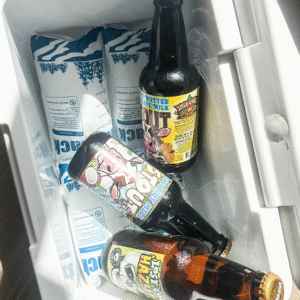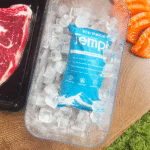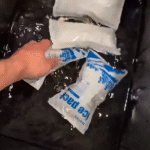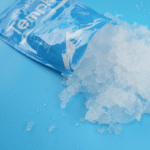Paket kecil es kering: Memilih, Ukuran & Kapal masuk 2025
Jika Anda membutuhkan paket kecil es kering yang membuat pengiriman beku dan patuh, Ini buku pedomannya. Pilih kantong yang ramah untuk ventilasi, Ukuran refrigeran dengan benar, dan menerapkan UN1845/kelas 9 Label untuk udara. Perjalanan penumpang dibatasi hingga 2.5kg, dan USPS Air Mail Caps Dry Es dengan 5lb per potong. Gunakan estimator ukuran di bawah ini untuk merencanakan massa sebelum tes jalur.
-
Saat paket kecil es kering mengalahkan gel/PCM untuk integritas beku sejati di jalur persil
-
Berapa banyak paket kecil es kering yang Anda butuhkan selama 24–72 jam dalam kondisi ringan, hangat, dan rute panas
-
Cara mengemas dan memberi label di bawah PI954 (UN1845) jadi operator menerima kotak Anda untuk pertama kalinya
-
Keamanan dan 2025 pembaruan itu penting untuk udara, tanah, dan perjalanan penumpang
Apa itu bungkus kecil es kering—dan kapan Anda harus menggunakannya?
Paket kecil es kering adalah kompak, konfigurasi berventilasi yang menampung es kering di dalam pengirim berinsulasi untuk menjaga muatan ≤−18°C selama 24–72 jam. Gunakan saat produk harus tetap beku sepenuhnya dan operator Anda menerima UN1845. Hindari kantong yang tertutup rapat; es kering harus dibuang karena menyublim menjadi gas CO₂.
Secara sederhana: paket gel berada di dekat 0°C; banyak PCM yang memiliki suhu +3/+5/+7/+17°C—bagus untuk jalur dingin, bukan untuk hasil yang sulit dibekukan. Suhu es kering mendekati −78,5°C, memberi Anda ruang kepala yang sangat dingin saat melakukan serah terima dan membuka pintu. Pilih gel/PCM hanya jika pita dingin dapat diterima dan Anda tidak ingin menangani barang berbahaya.
Paket kecil es kering vs. gel/PCM untuk tujuan parsel umum
Intinya: pilih alat yang sesuai dengan sasaran suhu dan batasan penerimaan Anda.
| Gunakan kasing (sasaran) | Pilihan terbaik | Durasi khas | Apa artinya ini bagi Anda |
|---|---|---|---|
| Es krim, daging (tetap beku) | Paket kecil es kering | 24–72H | Membutuhkan ventilasi + UN1845/Class9 melalui udara; integritas beku yang kuat. |
| 2–8°C farmasi atau perlengkapan makan | +5 °C PCM atau gel | 12–96h | Ketat, pita yang tidak beku; penanganan dan pelabelan yang lebih sederhana. |
| Kue-kue yang peka terhadap panas (+17 ° C.) | +17 ° C PCM | 24–72H | Menghindari mekar; validasi di jalur panas sebelum peningkatan skala. |
Tip Praktis untuk Anda
-
Lubang angin, jangan disegel: jangan pernah memanaskan es kering dalam plastik; gunakan kantong atau kantong kertas yang ramah ventilasi.
-
Prasyarat: bekukan produk pada suhu ≤−18°C dan dinginkan terlebih dahulu di pengirim untuk memperpanjang waktu tunggu.
-
Bagikan massa: bagi es kering menjadi beberapa bungkus kecil dan letakkan beberapa di atasnya untuk mengurangi titik panas.
Cuplikan dunia nyata: Sebuah toko roti mengirimkan croissant dengan dua kantong kertas berventilasi (~total 6 pon) di dalam pengirim EPS. Dengan label UN1845/Class9, kotak tersebut bertahan di bawah suhu −15°C selama 36 jam dan lolos penerimaan pada percobaan pertama.
Berapa banyak bungkus kecil es kering yang Anda perlukan selama 24–72 jam?
Aturan praktis yang cepat: rencana 5–10lb (2.3–4.5kg) per 24 jam dalam pendingin ukuran parsel. Gunakan high-end untuk jalur yang ramai atau pintu yang sering terbuka, dan tambahkan hari penyangga untuk penundaan.
Estimator fisika pertama (lebih tepat): es kering menyerap sekitar 571 kJ/kg saat ia menyublim. Lipat gandakan kebocoran panas setiap jam dengan jam transit, lalu bagi dengan 571, dan tambahkan buffer 10–20%.. Ini adalah titik awal yang dapat diandalkan sebelum pengujian jalur.
Rentang awal yang disarankan (dengarkan setelah tes jalur pertama Anda):
| Lamanya | Lembut (≤22 ° C.) | Hangat (23–30 ° C.) | Panas (≥31 ° C.) | Mengapa ini penting |
|---|---|---|---|---|
| ~ 24h | 2–3kg | 3–5kg | 5–6kg | Bagi menjadi ≥2 bungkus; tambahkan cakupan teratas. |
| ~ 48h | 4–6kg | 6–8kg | 8–11kg | Tambahkan sisi + paket teratas untuk stabilitas. |
| ~ 72h | 6–8kg | 9–12kg | 12–15kg | Pertimbangkan kotak yang lebih besar atau isolasi yang lebih baik. |
Penempatan & ukuran kotak (rincian praktis)
-
Volume kotak: 10–Pengirim 20L biasa menggunakan paket kecil es kering. Kotak yang lebih besar meningkatkan beban panas.
-
Layering: tas bawah → muatan → tas atas; tambahkan tas samping untuk > 48h. Isi kekosongan untuk memperlambat konveksi.
-
Trik hibrida: PCM tipis bersuhu −20°C yang menyentuh produk dapat memperlancar bukaan pintu sekaligus menjaga massa es kering tetap sederhana.
Cara mengemas dan memberi label pada kemasan kecil es kering 2025?
Kepatuhan inti (udara): gunakan kemasan itu memungkinkan pelepasan CO₂, tanda “Karbon dioksida, padatan "atau" es kering " + UN1845 + Kg net, dan terapkan a Label Class9 di wajah yang sama. Gunakan IATA PI954 daftar periksa penerimaan pada tender. Kantong plastik tertutup dilarang.
SOP langkah demi langkah dapat Anda tempelkan ke manual Anda:
-
Siapkan kantong yang ramah ventilasi (kantong atau selongsong kertas es kering). Melakukan bukan segel es kering kedap udara.
-
Layer dengan cerdas: paket bawah → muatan → paket atas; tambahkan sisi untuk jalur yang lebih panjang.
-
Ventilasi pengirim luar: tutup rapat tetapi hindari segel kedap udara; meninggalkan jalur gas.
-
Beri label dengan jelas: Nama diri UN1845 + Kg net + Label Class9 (≥100mm).
-
Pesan dengan benar: beberapa operator meminta kg bersih pada saat pemesanan untuk mengatur batasan pesawat.
Udara, tanah, USPS, dan nuansa penumpang
-
Perjalanan penumpang: ≤2.5kg (5.5 lb) per penumpang/paket dengan persetujuan maskapai; paket harus melampiaskan dan ditandai.
-
USPS Air Mail: ≤5 pon es kering per kiriman surat berdasarkan Instruksi Pengemasan 9A; diperlukan ventilasi dan penandaan.
-
Catatan pembawa: FedEx menegaskan kembali tidak adanya plastik tersegel dan menetapkan batas maksimum 200kg/paket (jauh di atas kebutuhan paket kecil). Jaringan UPS/ekspres mencerminkan aturan ventilasi dan penandaan PI954.
Keamanan paket kecil es kering: Aturan sederhana yang mencegah insiden
Daftar pendek yang menyelamatkan sakit kepala: ventilasi ruangan, kenakan sarung tangan terisolasi dan pelindung mata, dan jangan pernah menjebak CO₂ dalam lapisan tertutup. Latih staf untuk menangani potongan-potongan kecil dengan penjepit dan menghindari pengepakan di kendaraan tertutup atau ruangan dingin dengan aliran udara yang buruk.
Daftar periksa keamanan cepat
-
Ventilasi setiap lapisan: kantong → lapisan dalam (membuka) → pengirim luar (ventilasi).
-
APD: sarung tangan yang kompatibel dengan cryo, minimal kacamata pengaman.
-
Tidak ada segel kedap udara: jangan pernah memanaskan es kering dalam plastik; meninggalkan jalur gas.
-
Area pementasan: jauhkan dari ruang terbatas; CO₂ dapat berkumpul dalam jumlah rendah dan menggantikan oksigen.
2025 pembaruan dan tren paket kecil es kering
Apa yang baru: 2025 alat bantu pekerjaan operator menekankan kemasan ventilasi, tanda UN1845 yang jelas, dan menyediakan kg bersih pada saat pemesanan. Harapkan audit penerimaan yang memverifikasi daftar periksa PI954 bahkan untuk paket yang sangat kecil. Ketersediaan es kering eceran tetap kuat melalui pedagang grosir besar untuk pengisian ulang di menit-menit terakhir.
Perkembangan terbaru sekilas
-
Dokumentasi yang lebih kuat: Adendum IATA edisi ke-66 memperketat permintaan data pemesanan untuk es kering.
-
Paket lebih aman: stres pada halaman operator tidak ada plastik bersegel dan ventilasi yang memadai.
-
Alternatif yang dingin sudah matang: +3/+5/+7/+17 °C PCM kini mencakup banyak jalur non-beku tanpa penanganan DG.
Wawasan pasar: pengirim semakin banyak memesan paket kecil es kering jalur beku yang sebenarnya dan menggeser pekerjaan 2–8°C ke PCM untuk mengurangi label, biaya tambahan, dan risiko pengecualian—semuanya dilakukan dengan tetap menjaga integritas produk.
Pertanyaan yang sering diajukan
Berapa banyak es kering bungkus kecil selama 48 jam?
Rencana 10–20lb Tergantung pada isolasi dan panas sekitar; tambahkan hari buffer untuk penundaan atau hot hub.
Label apa yang ditempelkan pada bungkusan kecil es kering melalui udara?
Menerapkan UN1845 Nama pengiriman yang tepat, Kg net, dan a Kelas9 label (≥100mm) di wajah yang sama; ikuti daftar periksa penerimaan PI954.
Bisakah saya menyegel es kering di dalam kantong plastik?
TIDAK. Plastik tertutup dilarang. Pengemasan harus memungkinkan CO₂ keluar dengan aman.
Berapa tunjangan penumpangnya?
Hingga 2.5 kg (5.5 lb) per penumpang/paket dengan persetujuan maskapai; paket harus melampiaskan dan ditandai.
Apakah USPS mengizinkan es kering?
Ya. Surat udara potongan terbatas pada ≤5lb dan harus memenuhi Instruksi Pengemasan 9A.
Ringkasan & Rekomendasi
Kunci takeaways: paket kecil es kering memberikan kontrol pembekuan ketika gel/PCM tidak mencukupi. Kesuksesan berasal dari kemasan ventilasi, UN1845 + Kg net + Kelas9 tanda, Dan ukuran yang tepat dengan 571 kJ/kg estimator sebelum validasi jalur. Ikuti PI954 dan variasi operator untuk menghindari penolakan.
Langkah selanjutnya (rencana aksi):
-
Memetakan waktu transit dan puncak ambien.
-
Mulailah dengan 5–10lb per 24 jam dan dibagi menjadi beberapa paket.
-
Cetak label ke operator Anda 2025 panduan tinggi karakter.
-
Jalankan tes jalur dengan logger; menyesuaikan ±10–20%.
CTA: Bagikan jalur Anda, massa muatan, dan ukuran kotak—kami akan mengembalikan SOP paket kecil yang divalidasi.
Tentang tempk
Kami fokus pada tim pengemasan rantai dingin validasi praktis. Kami menggabungkan perkiraan termal cepat dengan uji rute nyata untuk menyesuaikan massa bongkahan es kering yang kecil, templat tanda-dan-label, dan daftar periksa pemesanan. Pelanggan memilih kami untuk SOP yang cepat Dan lebih sedikit masalah penerimaan—Khususnya di jalur panas dan rute multi-stop.
Siap mendesain paket kecil Anda? Hubungi spesialis Tempk untuk mengetahui spesifikasi dan SOP khusus jalur.
























